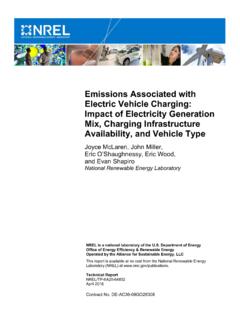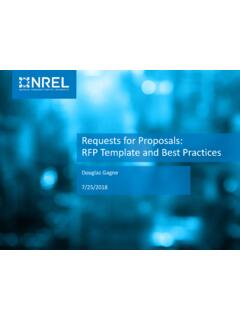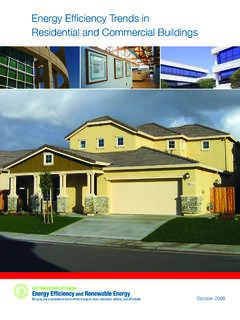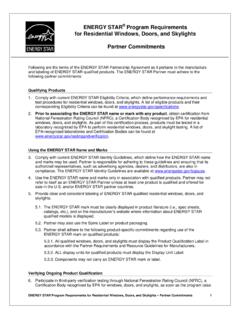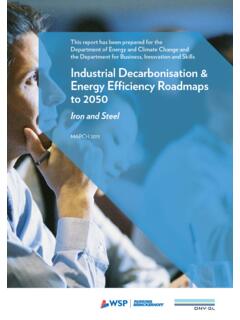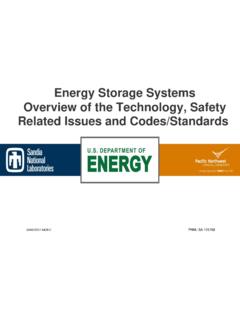Transcription of Methodology for Thermal Efficiency and Energy Input ...
1 Technical Support Document for the Revisions to Definition of Cogeneration Unit in Clean Air Interstate Rule (CAIR), CAIR Federal Implementation Plan, Clean Air Mercury Rule (CAMR), and CAMR Proposed Federal Plan; Revision to National Emission Standards for Hazardous Air Pollutants for Industrial, Commercial, and Institutional Boilers and Process Heaters; and Technical Corrections to CAIR and Acid Rain Program Rules Methodology for Thermal Efficiency and Energy Input Calculations and Analysis of Biomass Cogeneration Unit Characteristics EPA Docket number: EPA-HQ-OAR-2007-0012 April 2007 Environmental Protection Agency Office of Air and Radiation Technical Support Document for Proposed Revisions to Cogeneration Definition in CAIR, CAIR FIP, CAMR, and Proposed CAMR Federal Plan 1 This Technical Support Document (TSD) has several purposes.
2 One purpose of the TSD is to set forth the Methodology for determining the Thermal Efficiency of a unit for purposes of applying the definition of the term cogeneration unit under the existing CAIR, the CAIR model trading rules, the CAIR FIP, CAMR, the CAMR Hg model trading rule, and the proposed CAMR Federal Plan. Another purpose of the TSD is to present information relevant to the proposed revisions, and other potential revisions for which EPA is requesting comment, concerning the Thermal Efficiency standard. One of the critical values used in the determination of Thermal Efficiency is the total Energy Input of the unit.
3 Consequently, in connection with setting forth the Methodology for determining Thermal Efficiency , the TSD specifically addresses what formula is to be used in calculating a unit s total Energy Input under the existing rules. There are two major issues concerning the calculation of total Energy Input . The first issue is whether, under the existing rules, total Energy Input is determined based on the higher or lower heating value of the fuel or fuels combusted in the unit and how to calculate heating value. As discussed below, EPA maintains that, under the existing rules, total Energy Input constitutes the lower heating value of the fuel or fuels combusted by the unit, and EPA is requesting comment on whether the existing rules should be revised to state explicitly the formula for calculating total Energy Input using lower heating value.
4 The second issue is whether and to what extent the existing rules should be revised to exclude non-fossil fuel (such as biomass) from the calculation of total Energy Input . As discussed below, EPA is requesting comment on the proposed revision, and other potential revisions, concerning such exclusion. EPA is not requesting comment on any other aspects of the Thermal Efficiency standard such as, for example, the adoption of a standard as part of the definition of the term cogeneration unit, the specific percentages of total Energy output that must be met, or the treatment of useful Thermal Energy in the Thermal Efficiency standard.
5 Another purpose of the TSD is to address the information that EPA has developed concerning the units potentially affected by the proposed change to the existing rules concerning the extent to which non-fossil fuel should be excluded from the calculation of a unit s total Energy Input . As discussed in the preamble of the proposed rule for which this TSD is provided, EPA has taken Technical Support Document for Proposed Revisions to Cogeneration Definition in CAIR, CAIR FIP, CAMR, and Proposed CAMR Federal Plan 2 a number of steps to gather the most complete information we could about the number, size, location, industry, fuel use, electricity sales, and environmental impacts of the units potentially affected by the proposed change concerning the exclusion of non-fossil fuel from the calculation of total Energy Input .
6 The TSD provides more detailed information about the biomass cogeneration unit inventory, data sources, and emissions calculations that EPA used in its analysis for the proposed rule. I. Thermal Efficiency and Total Energy Input In this section of the TSD, EPA describes the Methodology for calculating Thermal Efficiency of a unit in order to help determine whether the unit qualifies for the cogeneration unit exemption. In addition, EPA addresses the definition and calculation of total Energy Input , which is used in calculating Thermal Efficiency in order to determine whether the unit qualifies for the cogeneration unit exemption.
7 A. Determining Thermal Efficiency In CAIR, the CAIR model trading rules, the CAIR FIP, CAMR, the CAMR Hg model trading rule, and the proposed CAMR Federal Plan, EPA included, as one criterion that a unit must meet in order to potentially qualify for the cogeneration unit exemption, the requirement that the unit meet a Thermal Efficiency standard. In adopting a Thermal Efficiency standard, EPA decided to use the Thermal Efficiency standard adopted by the Federal Energy Regulatory Commission (FERC) in determining whether a unit is a qualifying cogeneration unit under section (3)(18)(B) of the Federal Power Act (as amended by the Public Utility Regulatory policy Act (PURPA)).
8 However, EPA decided to make the Thermal Efficiency standard applicable to all fuels combusted by a unit, while the FERC limited application of the standard to natural gas and oil. (See 18 CFR (a)(2) and (b)(1). See 70 FR 25277). The Methodology for determining Thermal Efficiency adopted by EPA in the existing rules can be represented as the following: Thermal Efficiency = (Net Electric Output + Net Thermal Output/2)/Fuel Heat Input (LHV) Technical Support Document for Proposed Revisions to Cogeneration Definition in CAIR, CAIR FIP, CAMR, and Proposed CAMR Federal Plan 3 More background on the decision to use a Thermal Efficiency standard and how to perform the Thermal Efficiency calculation can be found in the Cogeneration Unit Efficiencies Calculation TSD for B.
9 Calculating Total Energy Input 1. Higher Heating Value vs. Lower Heating Value A critical value used in applying the Thermal Efficiency standard is the total Energy Input for the year for which Thermal Efficiency is being calculated. One of the first steps in determining the total Energy Input for a unit is identifying the unit s fuel mix and the heat content or heating value of the fuel or fuels combusted by the unit. Heating value, commonly expressed in Btu, can be measured in several ways, but the most common are to use gross heat content (referred to as higher heating value or HHV ) or to use net heat content (referred to as lower heating value or LHV ).
10 According to the Energy Information Administration (EIA) of Department of Energy , higher heating value includes, while low heating value excludes, the Energy used to vaporize water (contained in the original Energy form or created during the combustion process). 2 As discussed above, EPA adopted in the existing rules the same Thermal Efficiency standard as that adopted by FERC in determining whether a unit is a qualifying cogeneration unit, except that EPA applied the Thermal Efficiency standard to all fuels and the FERC limited application of the standard to natural gas and oil.










